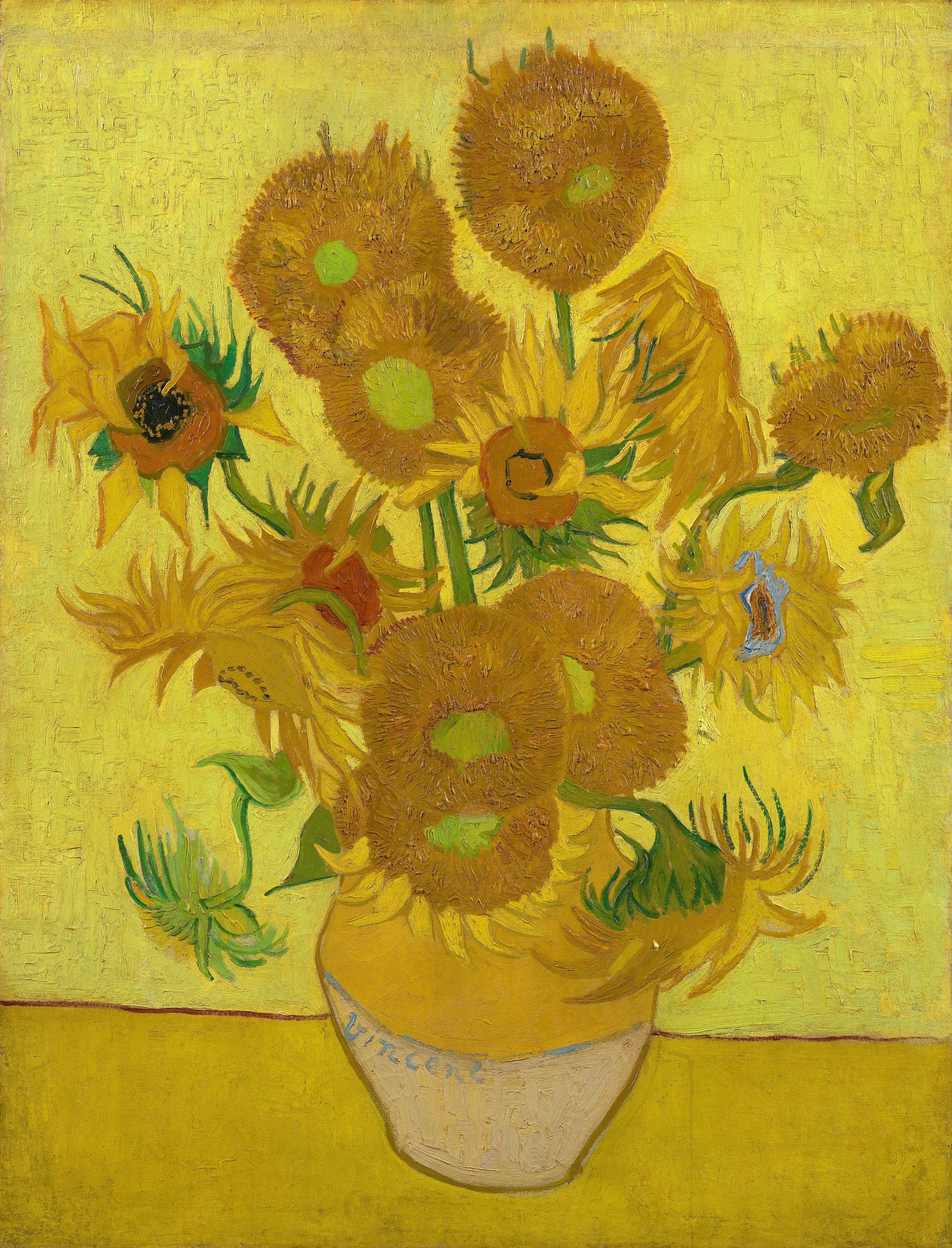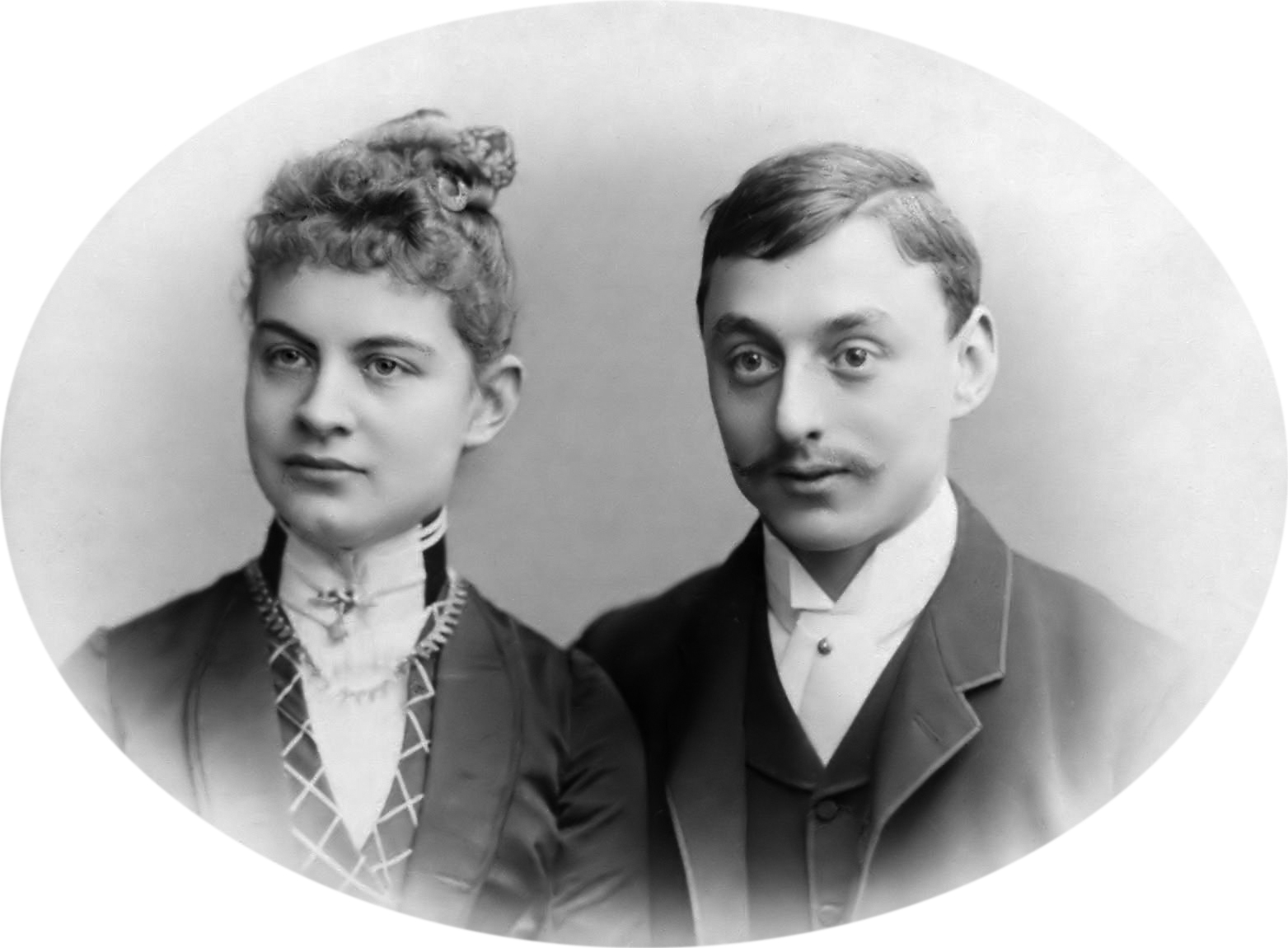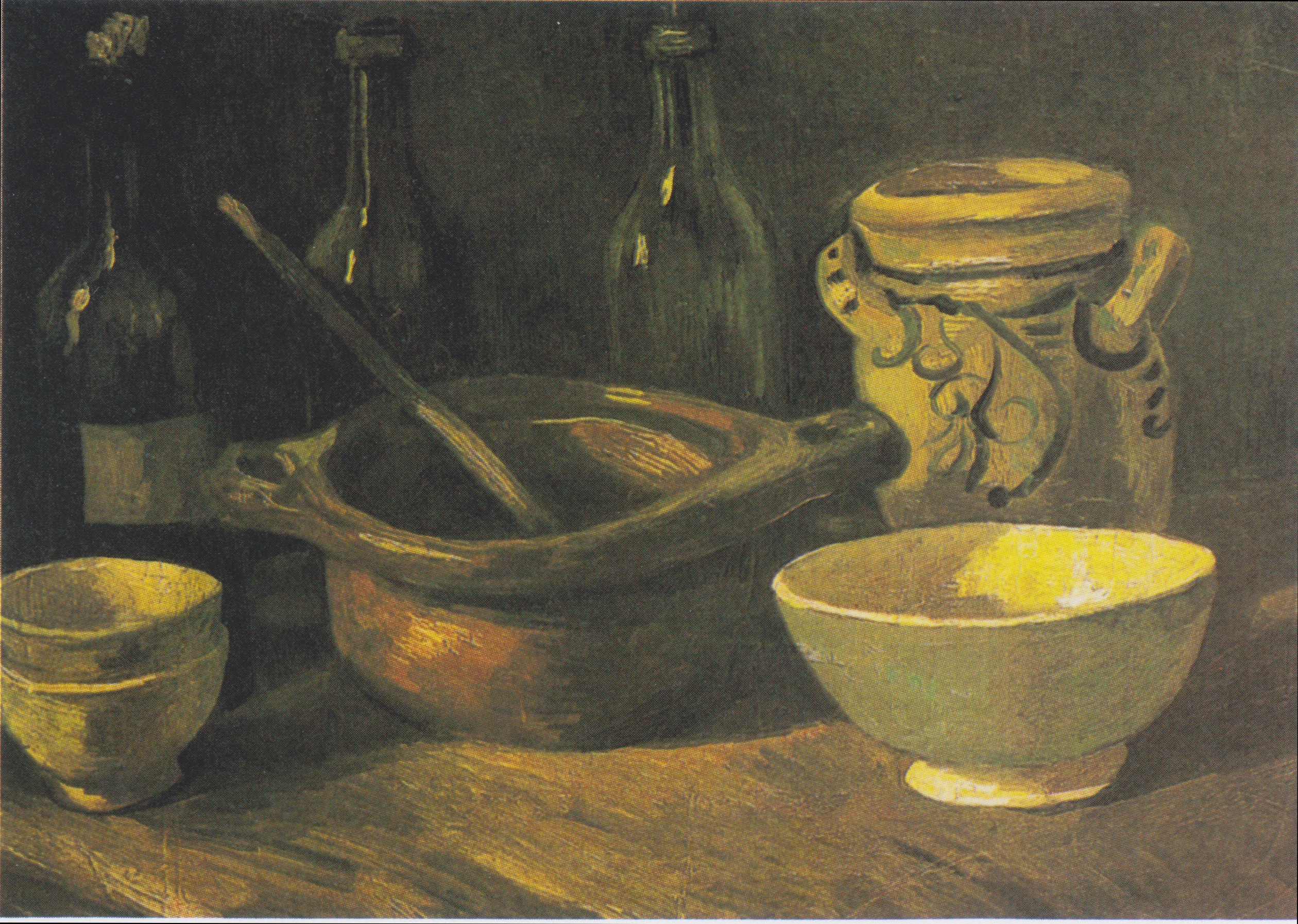|
Still Life With Straw Hat
''Still Life with Straw Hat (''Stillleben mit gelbem Strohhut'')'' also known as ''Still Life with Yellow Straw Hat'' and ''Still Life with Hat and Pipe'' was painted by Vincent van Gogh in late November - mid-December 1881 or possibly in 1885 in the town of Nuenen. Van Gogh in Nuenen In November 1884 Van Gogh taught some friends from Eindhoven, a large town near Nuenen, to paint inanimate objects in oil. Van Gogh, in his enthusiasm, created a series of still life paintings of bottles, bowls and pots and other objects. ''Still Life with Straw Hat'' was painted at Nuenen during this period. He wrote that the paintings would be hard to sell, but having deemed the effort valuable he painted still life compositions throughout the winter. The painting ''Still-Life with Straw Hat'' and another painting of this period, ''Still-life with Earthen Pot and Clogs,'' are regarded by critics and writers for their technical mastery. Both are characterized by smooth, meticulous brushwork and ... [...More Info...] [...Related Items...] OR: [Wikipedia] [Google] [Baidu] |
Vincent Van Gogh
Vincent Willem van Gogh (; 30 March 185329 July 1890) was a Dutch Post-Impressionist painter who posthumously became one of the most famous and influential figures in Western art history. In a decade, he created about 2,100 artworks, including around 860 oil paintings, most of which date from the last two years of his life. They include landscapes, still lifes, portraits and self-portraits, and are characterised by bold colours and dramatic, impulsive and expressive brushwork that contributed to the foundations of modern art. Not commercially successful, he struggled with severe depression and poverty, eventually leading to his suicide at age thirty-seven. Born into an upper-middle class family, Van Gogh drew as a child and was serious, quiet, and thoughtful. As a young man, he worked as an art dealer, often traveling, but became depressed after he was transferred to London. He turned to religion and spent time as a Protestant missionary in southern Belgium. He drif ... [...More Info...] [...Related Items...] OR: [Wikipedia] [Google] [Baidu] |
Jacob Baart De La Faille
Jacob Baart de la Faille (1 June 1886, Leeuwarden – 7 August 1959, Heemstede) compiled the first ''catalogue raisonné'' of the work of Vincent van Gogh, published in 1928. The catalogue was revised and republished by an editorial committee in 1970, and this version is considered to be the definitive catalogue of van Gogh's work. His catalogue numbers are preceded by an 'F': thus F612 refers to ''The Starry Night''. Shortly after the publication of the original catalogue, de la Faille became involved in a major fraud affair concerning the Berlin art dealer Otto Wacker. De la Faille had certified the authenticity of 30 paintings which were later determined to be fakes. Biography Jacob-Baart de la Faille was born to a Dutch father, Cornelis Baart de la Faille, and a Belgian mother, Henriette Adriana Krayenhoff. At the University of Utrecht he majored in law, not in art.Dr Jacob Baart de la Faille 1886–1959, in: Hammacher, ed., 1970, p. 39 Writings * J.-B. de La Faille: '' ... [...More Info...] [...Related Items...] OR: [Wikipedia] [Google] [Baidu] |
Jan Hulsker
Jan Hulsker (2 October 1907, The Hague – 9 November 2002, Vancouver) was a Dutch art historian especially noted for his work on Vincent van Gogh. He studied Dutch literature in Leiden and was promoted with a thesis on the author Aart van der Leeuw. In 1953, he was appointed to the Ministerie van Cultuur, Recreatie en Maatschappelijk werk, in charge of the art department. In 1959, he became general director in charge of culture at large (directeur-generaal voor culturele zaken). The establishment of the Vincent van Gogh Foundation and the Van Gogh Museum The Van Gogh Museum () is a Dutch art museum dedicated to the works of Vincent van Gogh and his contemporaries in the Museum Square in Amsterdam South, close to the Stedelijk Museum, the Rijksmuseum, and the Concertgebouw. The museum opened o ... in Amsterdam were among his major tasks. From the 1950s, Hulsker contributed to Van Gogh research, concentrating on the dating of Van Gogh's correspondence. In 1973, Hulsker's mos ... [...More Info...] [...Related Items...] OR: [Wikipedia] [Google] [Baidu] |
Otterlo
Otterlo is a village in the municipality of Ede of province of Gelderland in the Netherlands, in or near the Nationaal Park De Hoge Veluwe. The Kröller-Müller Museum, named after Helene Kröller-Müller, is situated nearby and has the world's second largest collection of Vincent van Gogh paintings. Otterlo was a separate municipality until 1818, when it merged with Ede. History Second World War During the first four years of the war, Otterlo was relatively unharmed. The local resistance made use of a secret telephone connection from an electrician's house, which in 2021 still stands at the dorpsstraat, behind barber Prophitius, to communicate with the allies below the river Rhine The Rhine ; french: Rhin ; nl, Rijn ; wa, Rén ; li, Rien; rm, label=Sursilvan, Rein, rm, label=Sutsilvan and Surmiran, Ragn, rm, label=Rumantsch Grischun, Vallader and Puter, Rain; it, Reno ; gsw, Rhi(n), including in Alsatian dialect, Al ... (1944/1945). During the war, multiple fam ... [...More Info...] [...Related Items...] OR: [Wikipedia] [Google] [Baidu] |
Netherlands
) , anthem = ( en, "William of Nassau") , image_map = , map_caption = , subdivision_type = Sovereign state , subdivision_name = Kingdom of the Netherlands , established_title = Before independence , established_date = Spanish Netherlands , established_title2 = Act of Abjuration , established_date2 = 26 July 1581 , established_title3 = Peace of Münster , established_date3 = 30 January 1648 , established_title4 = Kingdom established , established_date4 = 16 March 1815 , established_title5 = Liberation Day (Netherlands), Liberation Day , established_date5 = 5 May 1945 , established_title6 = Charter for the Kingdom of the Netherlands, Kingdom Charter , established_date6 = 15 December 1954 , established_title7 = Dissolution of the Netherlands Antilles, Caribbean reorganisation , established_date7 = 10 October 2010 , official_languages = Dutch language, Dutch , languages_type = Regional languages , languages_sub = yes , languages = , languages2_type = Reco ... [...More Info...] [...Related Items...] OR: [Wikipedia] [Google] [Baidu] |
Kröller-Müller Museum
The Kröller-Müller Museum () is a national art museum and sculpture garden, located in the Hoge Veluwe National Park in Otterlo in the Netherlands. The museum, founded by art collector Helene Kröller-Müller within the extensive grounds of her and her husband's former estate (now the national park), opened in 1938. It has the second-largest collection of paintings by Vincent van Gogh, after the Van Gogh Museum. The museum had 380,000 visitors in 2015. History The Kröller-Müller Museum was founded by Helene Kröller-Müller, an avid art collector who, being advised by H.P. Bremmer, was one of the first to recognize Vincent van Gogh's genius and collect his works. In 1935, she donated her whole collection to the state of the Netherlands. In 1938, the museum, which was designed by Henry van de Velde, opened to the public. The sculpture garden was added in 1961 and the new exhibition wing, designed by Wim Quist, opened in 1977. Collection The museum has a considerabl ... [...More Info...] [...Related Items...] OR: [Wikipedia] [Google] [Baidu] |
Nuenen
Nuenen () is a town in the municipality of Nuenen, Gerwen en Nederwetten in the Netherlands. From 1883 to 1885, Vincent van Gogh lived and worked in Nuenen. In 1944, the town was a battle scene during Operation Market Garden. The local dialect is called Peellands. In 2009, Nuenen had a population of 22,437. History Nuenen is listed in the 1792 Gazetteer of the Netherlands, which lists it as "a village of Brabant, two leagues W. from Helmont". World War II During Operation Market Garden on 20 September 1944, Nuenen was the scene of a battle involving the American 506th PIR of the 101st Airborne Division and the British 15th/19th The King's Royal Hussars of the 11th Armoured Division equipped with Cromwell tanks, against the German 107th Panzer Brigade. The British lost two tanks, and four American and three British soldiers were killed. The Germans suffered two fatalities. The fight is dramatised in episode 4 "Replacements" of the television series ''Band of Brothers''. D ... [...More Info...] [...Related Items...] OR: [Wikipedia] [Google] [Baidu] |
Eindhoven
Eindhoven () is a city and municipality in the Netherlands, located in the southern province of North Brabant of which it is its largest. With a population of 238,326 on 1 January 2022,Statistieken gemeente Eindhoven AlleCijfers.nl it is the fifth-largest city of the Netherlands and the largest outside the Randstad conurbation. Eindhoven was originally located at the of the Domm ... [...More Info...] [...Related Items...] OR: [Wikipedia] [Google] [Baidu] |
Impressionist
Impressionism was a 19th-century art movement characterized by relatively small, thin, yet visible brush strokes, open composition, emphasis on accurate depiction of light in its changing qualities (often accentuating the effects of the passage of time), ordinary subject matter, unusual visual angles, and inclusion of movement as a crucial element of human perception and experience. Impressionism originated with a group of Paris-based artists whose independent exhibitions brought them to prominence during the 1870s and 1880s. The Impressionists faced harsh opposition from the conventional art community in France. The name of the style derives from the title of a Claude Monet work, ''Impression, soleil levant'' ('' Impression, Sunrise''), which provoked the critic Louis Leroy to coin the term in a satirical review published in the Parisian newspaper '' Le Charivari''. The development of Impressionism in the visual arts was soon followed by analogous styles in other media that b ... [...More Info...] [...Related Items...] OR: [Wikipedia] [Google] [Baidu] |
Guilders
Guilder is the English translation of the Dutch and German ''gulden'', originally shortened from Middle High German ''guldin pfenninc'' " gold penny". This was the term that became current in the southern and western parts of the Holy Roman Empire for the Fiorino d'oro (introduced in 1252). Hence, the name has often been interchangeable with ''florin'' (currency sign ''ƒ'' or ''fl.''). The guilder is also the name of several currencies used in Europe and the former colonies of the Dutch Empire. Gold guilder The guilder or gulden was the name of several gold coins used during the Holy Roman Empire. It first referred to the Italian gold florin introduced in the 13th century. It then referred to the Rhenish gulden (florenus Rheni) issued by several states of the Holy Roman Empire from the 14th century. The Rhenish gulden was issued by Trier, Cologne and Mainz in the 14th and 15th centuries. Basel minted its own ''Apfelgulden'' between 1429 and 1509. Bern and Solothurn follow ... [...More Info...] [...Related Items...] OR: [Wikipedia] [Google] [Baidu] |
Still Life Paintings By Vincent Van Gogh (Netherlands)
''Still life paintings by Vincent van Gogh (Netherlands)'' is the subject of many drawings, sketches and paintings made during Vincent van Gogh's early artistic career. Most still lifes made in the Netherlands are dated from 1884 to 1885, when he lived in Nuenen. His works were often in somber colors. Van Gogh experimented with the use of light falling across objects. The next two years (1886–1887), transformed the subjects, color and techniques that van Gogh used in creating still life paintings. In Paris he painted many still life paintings of flowers, experimenting with color, light and techniques he learned from modern artists. Background Van Gogh moved to Nuenen in 1884 where he lived for two years. Upon van Gogh's arrival, a studio was made for him from a laundry room at the back of his parents' home. Vincent's father, Reverend van Gogh wrote to his son Theo: "We do not think it’s really suitable, but we have had a proper stove installed... I wanted to put in a larg ... [...More Info...] [...Related Items...] OR: [Wikipedia] [Google] [Baidu] |
Paintings By Vincent Van Gogh
Painting is the practice of applying paint, pigment, color or other medium to a solid surface (called the "matrix" or "support"). The medium is commonly applied to the base with a brush, but other implements, such as knives, sponges, and airbrushes, can be used. In art, the term ''painting ''describes both the act and the result of the action (the final work is called "a painting"). The support for paintings includes such surfaces as walls, paper, canvas, wood, glass, lacquer, pottery, leaf, copper and concrete, and the painting may incorporate multiple other materials, including sand, clay, paper, plaster, gold leaf, and even whole objects. Painting is an important form in the visual arts, bringing in elements such as drawing, composition, gesture (as in gestural painting), narration (as in narrative art), and abstraction (as in abstract art). Paintings can be naturalistic and representational (as in still life and landscape painting), photographic, abstract, narrative, sy ... [...More Info...] [...Related Items...] OR: [Wikipedia] [Google] [Baidu] |









